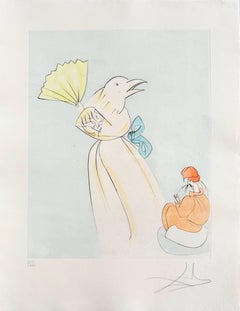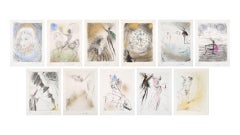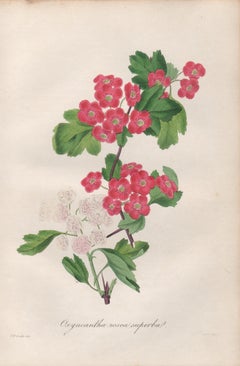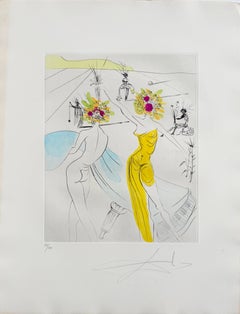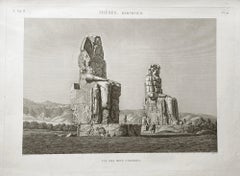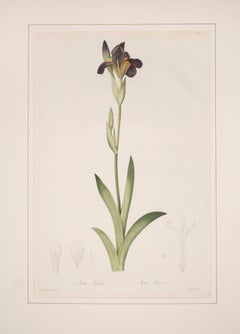Engraving More Prints
to
134
176
118
100
24
5
Overall Width
to
Overall Height
to
50
34
30
29
3
3
1
1
1
57
26
13
11
9
204
81
104
34
4
1
4
1
3
3
29
39
3
9
160
254
167
2
6
3
2
2
2
2
2
2
2
1
1
1
1
1
1
1
1
1
1
1
4,879
2,999
2,171
1,205
1,190
55
100
195
108
Medium: Engraving
Shitakiri (The tongue-cut sparrow)
Located in OPOLE, PL
Salvador Dali (1904-1989) - Shitakiri (The tongue-cut sparrow)
Drypoint etching with stencil from 1974.
The edition of XVII/LXXV on Richard de Bas paper.
Dimensions of work: 66 x ...
Category
1970s Surrealist Engraving More Prints
Materials
Drypoint, Etching
Faust (Walpurgis Night)
Located in OPOLE, PL
Salvador Dali (1904-1989) - Faust (Walpurgis Night)
Portfolio of 11 drypoint etchings with roulette from 1969.
The edition 142/145.
Dimensions of work: 38 x 28 cm.
Hand signed.
...
Category
1970s Surrealist Engraving More Prints
Materials
Etching, Drypoint
Oxyacantha rosea superba, antique botanical pink flower engraving
Located in Melbourne, Victoria
Engraving with original hand-colouring. 1834. 230mm by 155mm. From Paxton's 'Magazine of botany and register of flowering plants' by Sir Joseph Paxton.
Category
Mid-19th Century Naturalistic Engraving More Prints
Materials
Engraving
Femme-fleurs au piano (Flower-women at the Piano)
Located in OPOLE, PL
Salvador Dali (1904-1989) - Femme-fleurs au piano (Flower-women at the Piano)
Drypoint etching from 1969.
The edition 25/145 on Arches paper.
Dimensions of work: 66 x 51 cm.
Hand...
Category
1960s Surrealist Engraving More Prints
Materials
Drypoint, Etching
Colossi of Memnon, Thebes, Egypt. Early 19th century engraving, 1820
Located in Melbourne, Victoria
'Vue des Deux Colosses. Thebes, Memnonium'
Elephant folio engraving, by Baltard after Dutetre, from 'Description de l'Egypte', published after Napoleon's expedition to colonize Egyp...
Category
Early 19th Century Other Art Style Engraving More Prints
Materials
Engraving
Iris Lurida. Iris Brune.
Located in London, GB
REDOUTE, Pierre-Joseph.
Iris Lurida. Iris Brune.
Paris, Chez L’Auteur, 1802-16
The highest peak of Redoute's artistic and botanical achievement... Among the most important monum...
Category
Mid-19th Century Naturalistic Engraving More Prints
Materials
Paper, Engraving
A View of Kauai, Hawaii Discovered by Captain Cook: Original 18th C. Engraving
By John Webber
Located in Alamo, CA
"View of A Morai or Burial Place of Atooi, One of the Sandwich Islands (Kauai, Hawaii)" is an original 18th century engraving from a drawing by John Webber (1751-1793), who was the a...
Category
1780s Engraving More Prints
Materials
Engraving
Allée des Verges (Penis Alley)
Located in OPOLE, PL
Salvador Dali (1904-1989) - Allée des Verges (Penis Alley)
Etching from 1969.
125/145 on Japan paper.
Dimensions of work: 38 x 28 cm.
Hand signed.
Publisher: Graphik Europa Anst...
Category
1970s Surrealist Engraving More Prints
Materials
Drypoint, Etching
Nova Totius Terrarum Orbis Geographica Ac Hydrographica Tabula
Located in New York, NY
Copper-plate engraving, hand-colored, 1608 - c.1630 and published by Joannes Jansonius, Amsterdam. Image size 15.75 x 21.19 inches (40 x 53.9 cm).
A classic example of a world ma...
Category
17th Century Other Art Style Engraving More Prints
Materials
Engraving
Four Framed Hogarth Engravings "Four Times of the Day"
Located in Alamo, CA
The four plates in this "Four Times of the Day" set were created utilizing both engraving and etching techniques by William Hogarth in 1738. Hogarth's original copper plates were refurbished where needed by James Heath and these engravings were republished in London in 1822 by Braddock, Cradock & Joy. This was the last time Hogarth's original copper plates were used for printing. Most were melted down during World War I for the construction of bombs. Printed upon early nineteenth century wove paper and with large, full margins as published by William Heath in 1822. The inscription below each print reads "Invented Painted & Engraved by Wm. Hogarth & Publish'd March 25. 1738 according to Act of Parliament".
These large folio sized "Four Times of the Day" engravings/etchings are presented in complex gold-colored wood frames with black bands and scalloped gold inner trim. A majority of each thick impressive frame is covered with glass applied near the outer edge. Each frame measures 25.75" high, 22.25" wide and 1.88" deep. There are a few small dents in the edge of these frames, which are otherwise in very good condition. "Morning" has two focal areas of discoloration in the upper margin and some discoloration in the right margin, a short tear in the left margin and a short tear or crease in the right margin. "Noon" has a spot in the upper margin that extends into the upper image, but it is otherwise in very good condition. "Evening" has a faint spot in the upper margin, but it is otherwise in very good condition. "Night" is in excellent condition.
The "Four Times of the Day" series is in the collection of many major museums, including: The British Museum, The Metropolitan Museum of Art, The Tate Museum, The Chicago Art Institute and The Victoria and Albert Museum.
Through this series Hogarth is portraying early 18th century London street life at "Four Times of the Day". His characters are exhibiting their personalities, quircks, strange activities, but he also wants to draw attention the disparities between the wealthy aristocracy and the common working class.
Plate 1, "Morning" depicts morning in Covent Garden in the winter in front of Tom King...
Category
Mid-18th Century Old Masters Engraving More Prints
Materials
Engraving, Etching
$5,420 Sale Price
20% Off
Johann Weinmann: c18th Botanical Engravings in Decalcomania Frames
Located in Richmond, GB
A wonderful selection of hand-coloured mezzotint engravings from: ""Phytanthoza Iconographia"", c1739, presented in hand- made parcel-gilt, ebonised and decalcomania frames.
Joha...
Category
18th Century Engraving More Prints
Materials
Watercolor, Mezzotint
The Hippies
Located in OPOLE, PL
Salvador Dali (1904-1989) - The Hippies
Drypoint etching from 1969.
The edition 25/145 on Arches paper.
Dimensions of work: 66 x 51 cm.
Hand signed.
Publisher: Pierre Argillet, ...
Category
1960s Surrealist Engraving More Prints
Materials
Drypoint, Etching
$104,605
The Hippies
Located in OPOLE, PL
Salvador Dali (1904-1989) - The Hippies
Drypoint etching from 1969.
The edition 25/145 on Arches paper.
Dimensions of work: 66 x 51 cm.
Hand signed.
Publisher: Pierre Argillet, ...
Category
1970s Surrealist Engraving More Prints
Materials
Drypoint, Etching
$104,605
The Fighting Temeraire: A Framed 19th C. Engraving After J. M. W. Turner
By J.M.W. Turner
Located in Alamo, CA
This beautiful 19th century framed engraving "The Fighting Temeraire" by James Tibbetts Willmore is based on an original painting by the renowned British artist J.M.W. Turner. It was published by James S. Virtue & Co. in London between 1859-1875. It depicts the once mighty British warship the HMS Temeraire being towed away down the river Thames by a much smaller steamboat to a ship-breaking yard to be broken up for scrap. The Temeraire was first launched in 1798 and represented the pinnacle of British ship-building. 180-feet long, constructed of English oak and armed with 98 guns, she was one of the largest warships of the period. The Temeraire became a symbol of British pride and military power that endured throughout the 19th century. The man-of-war served during the French Revolutionary and Napoleonic Wars and was among the last serving ships to have been at the Battle of Trafalgar in 1805. It became one of the many older ships put out of service in the 1830s and 1840s. The once mighty and feared ship symbolizes a once magnificent, but now obsolete, technology. Turner seems to lament her inglorious final journey, being towed by a less magnificent, but modern steam powered tugboat.
The Turner painting was created in 1838 and is now held in the National Gallery in London. Willmore's engraving, created in 1859, captures the dramatic scene with great detail and skill. The image has become an iconic representation of the decline of Britain's naval power and the transition from sail to steam in the 19th century. The sunset in the background is symbolic of the sun going down on British naval power and tradition. The painting conveys profound and diverse themes that are central to the human experience: those of mortality and change, technology and progress, heroism and brutality. The painting demonstrates Turner’s skill as an artist. His ability to produce scenes of great beauty that are dramatic, but are also symbolic, stimulating both thoughtful analysis, as well as emotion. Turner's painting was voted by the British public in a 2005 BBC radio sponsored survey to be the British people's favorite painting of all time. In 2020 it was included on a new British banknote...
Category
Mid-19th Century Romantic Engraving More Prints
Materials
Engraving
$540 Sale Price
20% Off
A View of Kauai, Hawaii as Seen by Captain Cook: An Original 18th C. Engraving
By John Webber
Located in Alamo, CA
"An Inland View in Atooi, One of the Sandwich Islands (Kauai, Hawaii)" is an original 18th century engraving from a drawing by John Webber (1751-1793), who was the artist who accompa...
Category
1780s Engraving More Prints
Materials
Engraving
Four 19th Century Hand Colored Engravings Depicting English Royal Residences
By Charles Wild
Located in Alamo, CA
Four hand colored etchings and aquatints depicting interiors within English royal residences, including "The Blue Velvet Room at Carlton House", "The Queen's Library at Frogmore", "T...
Category
1810s Academic Engraving More Prints
Materials
Engraving
$1,248 Sale Price
36% Off
Sandwich Islands Canoe (Hawaii): Framed 18th C. Engraving Captain Cook's Journal
By John Webber
Located in Alamo, CA
"A Canoe of the Sandwich Islands, the Rowers Masked" is an engraving created by Charles Grignion, from a drawing by John Webber (1752-1793), who was the artist on Captain James Cook's 3rd and final voyage of discovery. It is Plate 65 in the atlas of "A Voyage to the Pacific Ocean Undertaken by the Command of His Majesty, for Making Discoveries in the Northern Hemisphere", the official British Admiralty sanctioned journal published upon completion of the voyage in London in 1784 by Strahan & Cadell.
This famous image of ten Hawaiian rowers transporting a priest who is carrying a feather-covered image of Kukailimoku, the Hawaiian god of war. The priests and paddlers are all wearing gourd masks in their double-hulled canoe with an upright lateen woven sail. Each hull was shaped from a single large Koa log harvested from island rainforests, where they were carved before being transported to the coast.
This engraving is presented in a Koa wood frame and a white mat. There are occasional faint spots, but the print is otherwise in very good condition. Koa is the same wood as was used to make the canoe. Koa wood is legendary in Hawaii. Not only is this amazing wood native to Hawaii, but it is known for the deep rich colors and varied grain pattern. Koa has an honored heritage in Hawaii and is highly revered and sacred. The word “koa” means “warrior” in Hawaiian. The warriors of King Kamehameha the Great, created canoes and weapons from a wood plentiful on the Big Island of Hawaii. This wood became synonymous with the warriors themselves, and it became known as koa. The frame measures 20.75" high, 26.75" wide and 0.88" deep.
There are three other engravings listed from the official journal of Captain Cook's 3rd voyage available that are presented in identical Koa wood frames and mat (LU117324682022, LU117324684052, LU117324684062). They would make a wonderful grouping for a display of 2, 3 or 4 prints. A discount is available for a grouping depending on the number of items included.
Hawaii was discovered by Captain Cook (1728-1779) during this voyage. Hawaii was originally called The Sandwich Islands in honor of The Earl of Sandwich...
Category
1780s Engraving More Prints
Materials
Engraving
Boats of the Friendly Isles, Tonga: Original 18th C. Engraving from Captain Cook
Located in Alamo, CA
"Boats of the Friendly Isles" is an original 18th century engraving from a drawing by William Hodges (1744-1797), who was the artist who accompanies Captain Cook on his second voyage...
Category
1780s Engraving More Prints
Materials
Engraving
Tropaeolum Majus Atrosanguineum, antique botanical nasturtium flower engraving
Located in Melbourne, Victoria
Engraving with original hand-colouring. 1834. 230mm by 155mm. From Paxton's 'Magazine of botany and register of flowering plants' by Sir Joseph Paxton.
Category
Mid-19th Century Naturalistic Engraving More Prints
Materials
Engraving
Le Carmen des Carmen
Located in OPOLE, PL
Pablo Picasso (1881-1973) - Le Carmen des Carmen
Portfolio with three aquatints (one with etching), one drypoint,
and one lithograph, plus 91 collotypes after drawings from 1968.
T...
Category
1960s Modern Engraving More Prints
Materials
Drypoint, Etching, Aquatint
Plan of the Park, Garden and Plantations of Goodwood, 18th century engraving
Located in Melbourne, Victoria
Plan of the Park, Garden and Plantations of Goodwood in Sussex the Seat of his Grace the Duke of Richmond and Lenox &c
Copper-line engraving with later hand-colouring by Hendrik Hul...
Category
18th Century English School Engraving More Prints
Materials
Engraving
Ahyouwaighs, Chief of Six Nations: Hand-colored McKenney Folio-sized Lithograph
Located in Alamo, CA
This is an original 19th century hand-colored folio size McKenney and Hall engraving of a Native American entitled "Ahyouwaighs, Chief of the Six Nat...
Category
1830s Naturalistic Engraving More Prints
Materials
Engraving
Portrait de Marguerite (Portrait of Marguerite)
Located in OPOLE, PL
Salvador Dali (1904-1989) - Portrait de Marguerite (Portrait of Marguerite)
Drypoint etching with roulette from 1969.
The edition 142/145.
Dimensions of work: 38 x 28 cm.
Hand si...
Category
1970s Surrealist Engraving More Prints
Materials
Drypoint, Etching
"Gobbledygook" monoprint with collage, engraving and embossment by Mel Bochner
By Mel Bochner
Located in Boca Raton, FL
"Gobbledygook" monoprint with collage, engraving and embossment on hand-dyed Twinrocker handmade paper from Two Palms Publishing. Signed and dated Bochner 2017 lower right recto. Ima...
Category
2010s Contemporary Engraving More Prints
Materials
Oil, Handmade Paper, Engraving
Reception for Captain Cook, Tonga: Original 18th C. Engraving, Cook's 3rd Voyage
By John Webber
Located in Alamo, CA
"The Reception of Capt. Cook in Hapaee" is an original 18th century engraving from a drawing by John Webber (1751-1793), who was the artist who accompanied Captain Cook on his third ...
Category
1780s Engraving More Prints
Materials
Engraving
Elevations de Divers Especes de Dessus de Portes, Roubo French design engraving
Located in Melbourne, Victoria
'Elevations de Divers Especes de Dessus de Portes'
French copper-line engraving by JB Bichard after Andre Jacob Roubo (1739–1791). 18th century laid watermarked paper.
From Roubo's...
Category
Late 18th Century French School Engraving More Prints
Materials
Engraving
Marica Sabini, antique botanical blue flower engraving
Located in Melbourne, Victoria
Engraving with original hand-colouring. 1834. 230mm by 155mm. From Paxton's 'Magazine of botany and register of flowering plants' by Sir Joseph Paxton.
Category
Mid-19th Century Naturalistic Engraving More Prints
Materials
Engraving
Fishing Off Hastings, England: A Framed 19th C. Engraving After J. M. W. Turner
By J.M.W. Turner
Located in Alamo, CA
This beautiful 19th century framed engraving "Line Fishing Off Hastings" by William Miller is based on an original painting by the renowned British artist J.M.W. Turner, which depicts a scene of fishermen at work off the coast of the town of Hastings in East Sussex, England. The Miller engraving faithfully reproduces Turner's painting, capturing the same atmospheric quality and sense of motion. In the foreground of the image, a group of fishermen are shown in a small boat, with one man using a fishing line to catch fish. In the background, there is a larger ship, along with a view of the town of Hastings and the cliffs beyond. Overall, the Miller engraving "Line Fishing Off Hastings" is a beautiful and detailed representation of Turner's original painting, and provides a glimpse into life in a 19th century fishing community.
This colorful 19th century engraving is presented in a gold-colored wood frame and a cream-colored French mat highlighted with a light blue band and thinner mustard and gold-colored bands. There is a gold-colored fillet which further embellishes the engraving. The frame measures 18" high, 20.5" wide and 1" deep. The engraving, frame and mat are in excellent condition.
Joseph Mallord William (J.M.W.) Turner (1775-1851) was an English painter who is widely considered one of the greatest landscape painters in Western art history. Born in London, he showed a remarkable talent for art from a young age, and studied at the Royal Academy of Arts from the age of 14. He quickly gained recognition for his watercolor landscapes, which were highly innovative and expressive. Turner's style evolved over time, and he became increasingly interested in the effects of light and color. He traveled extensively throughout Europe, and his experiences of the natural world, particularly the sea and the sky, had a profound influence on his art. His paintings are known for their luminosity, atmospheric effects, and dramatic use of color. Despite facing criticism and ridicule from some of his contemporaries, Turner continued to push the boundaries of art, experimenting with new techniques and styles throughout his career. He was a prolific artist, creating thousands of paintings, sketches, and watercolors, and his legacy continues to inspire artists today.
William Miller (1796-1882) was an English engraver and publisher, best known for his work in reproducing the paintings of J.M.W. Turner. Miller was born in Bristol and began his career as an engraver at a young age, working for a variety of publications and artists. In the early 1820s, Miller began working with Turner, engraving many of the artist's most famous works, including "The Fighting Temeraire...
Category
Mid-19th Century Romantic Engraving More Prints
Materials
Engraving
$460 Sale Price
20% Off
Malopa grandiflora, antique botanical flower engraving
Located in Melbourne, Victoria
Engraving with original hand-colouring. 1834. 230mm by 155mm. From Paxton's 'Magazine of botany and register of flowering plants' by Sir Joseph Paxton.
Category
Mid-19th Century Naturalistic Engraving More Prints
Materials
Engraving
A Night Dance by Men in Tonga: An Original 18th C. Engraving, Cook's 3rd Voyage
By John Webber
Located in Alamo, CA
"A Night Dance by Men in Hapaee" is an original 18th century engraving from a drawing by John Webber (1751-1793), who was the artist who accompanied Captain Cook on his third voyage ...
Category
1780s Engraving More Prints
Materials
Engraving
Map of the East Indies: An Original 18th Century Hand-colored Map by E. Bowen
Located in Alamo, CA
This is an original 18th century hand-colored map entitled "An Accurate Map of the East Indies Exhibiting the Course of the European Trade both on the Continent and Islands" by Emanu...
Category
Mid-18th Century Old Masters Engraving More Prints
Materials
Engraving
$1,020 Sale Price
20% Off
Framed Rubbing of 1550 Brass Monument in Grote Kerk Church, Breda, Netherlands
Located in Alamo, CA
This is an engraving of a tomb monument rubbing that has been highlighted with gold color on a dark grey to black background. The rubbing is of a brass plaque on a stone slab. It has...
Category
16th Century Northern Renaissance Engraving More Prints
Materials
Engraving
$1,260 Sale Price
20% Off
Champignon de la France, a French antique mushroom engraving, 1791
Located in Melbourne, Victoria
'L'Agaric Couleuvre'
A French copper-line engravings with original printed colouring of mushrooms by Jean Baptiste Francois Buillard (1742-1793).
From Bulliard's 'Histoire des Champignons de la France', a series of engravings describing the mushrooms of France, published in Paris in 1791. This series of engravings are 'probably the first botanical work completely colour-printed without retouching by hand' (Great Flower Books...
Category
Late 18th Century Naturalistic Engraving More Prints
Materials
Engraving
To-Ka-Con, A Sioux Chief: Hand-colored McKenney & Hall Folio-sized Lithograph
Located in Alamo, CA
This is an original 19th century hand-colored folio-size McKenney and Hall engraving of a Native American entitled "To-Ka-Con, A Sioux Chief", drawn ...
Category
1830s Naturalistic Engraving More Prints
Materials
Engraving
A View of Dover, England: A Framed 19th C. Engraving After J. M. W. Turner
By J.M.W. Turner
Located in Alamo, CA
This beautiful 19th century framed engraving "Dover" by Thomas Lupton is based on an original painting by the renowned British artist J.M.W. Turner, which depicts a panoramic view of the harbor of Dover, a town in southeastern England, that has been an important port for centuries. The engraving captures the dramatic sky and sea that Turner was known for, with billowing clouds and waves crashing against the shore. The town and its famous white cliffs are visible in the background, while ships and boats dot the harbor in the foreground. Several wooden rowboats...
Category
Mid-19th Century Romantic Engraving More Prints
Materials
Engraving
$460 Sale Price
20% Off
West Africa: A 17th Century Hand-Colored Map by Mercator/Hondius
Located in Alamo, CA
A 17th century hand-colored map entitled "Guineae Nova Descriptio" by Gerard Mercator and Jodocus Hondius, published in their 'Atlas Minor' in Amsterdam in 1635. It is focused on the...
Category
1630s Engraving More Prints
Materials
Engraving
$460 Sale Price
20% Off
"Africa Vetus": A 17th Century Hand-colored Map By Sanson
Located in Alamo, CA
This original hand-colored copperplate engraved map of Africa entitled "Africa Vetus, Nicolai Sanson Christianiss Galliar Regis Geographi" was originally created by Nicholas Sanson d...
Category
1690s Engraving More Prints
Materials
Engraving
$1,100 Sale Price
20% Off
Whales, engraving with original hand-colouring, circa 1815
Located in Melbourne, Victoria
Whales, engraving with original hand-colouring, circa 1815.
From Bilderbuch Zum Nutzen und Vergnugen Der Jugend by Friedrich Justin Bertuch (1747-1822), an encyclopaedic collection of Interesting Animals, Plants, Flowers, Fruits, Minerals, Costumes, Antiquities and other Interesting Objects...
Category
Early 19th Century Naturalistic Engraving More Prints
Materials
Engraving
Surrender of Tahiti to Captain Wallis: An Original 18th C. Engraving
By John Webber
Located in Alamo, CA
"A Representation of the Surrender of the Island of Otaheite to Capt.n Wallis, by the Supposed Queen of Oberea" is an original 18th century engraving created by Sparrow, from a drawi...
Category
1780s Engraving More Prints
Materials
Engraving
$200 Sale Price
20% Off
Shells, French 18th century natural history marine sea shell engraving
Located in Melbourne, Victoria
18th century natural history engraving depicting shells by Robert Benard after Henry Joseph Redoute.
Henry Redoute was the bro...
Category
Late 18th Century Victorian Engraving More Prints
Materials
Engraving
Tete de Veau (Calf's Head)
Located in OPOLE, PL
Salvador Dali (1904-1989) - Tete de Veau (Calf's Head)
Drypoint etching and watercolor from 1968.
The edition 25/145.
Dimensions of work: 38.5 x 28.5 cm.
Hand signed.
The work i...
Category
1960s Modern Engraving More Prints
Materials
Drypoint, Etching
Three Yellowlegs.
By Frank Benson
Located in New York, NY
The drypoint created in 1920 is a working state, the fourth of eight. The eight states are listed in the Frank W. Benson catalogue raisonne by Adam Paff #184. There are two recorded impressions of this print making it a rare find. It is signed in pencil and inscribed "D-2." The Image size 4 3/8 x 5 13/16" (11.1 x 14.8 cm). The final printed edition of "Three Yellowlegs" was 150.
Frank Weston Benson (1862-1951), well known for his American impressionist paintings, produced an incredible body of prints - etchings, drypoints, and a few lithographs. Born and raised on the North Shore of Massachusetts, Benson, a natural outdoorsman, grew up sailing, fishing, and hunting. While a teenager his fascination with drawing and birding developed simultaneously and continued throughout his life.
His first art instruction was with Otto Grundman at the Museum of Fine Arts in Boston, and then in 1883 in Paris at the Academie Julian where he studied the rigorous ‘ecole des beaux arts’ approach to drawing and painting for two years.
During the early 1880’s Seymour Haden visited Boston giving a series of lectures on etching. This introduction to the European etching...
Category
Early 20th Century American Realist Engraving More Prints
Materials
Drypoint
Ipomopsis Elegans, antique botanical red flower engraving
Located in Melbourne, Victoria
Engraving with original hand-colouring. 1834. 230mm by 155mm. From Paxton's 'Magazine of botany and register of flowering plants' by Sir Joseph Paxton.
Category
Mid-19th Century Naturalistic Engraving More Prints
Materials
Engraving
Le Soldat Du Chene, Osage Chief: Hand Colored McKenney Folio-sized Lithograph
Located in Alamo, CA
An original 19th century hand-colored folio-size McKenney and Hall lithograph of a Native American entitled "Le Soldat Du Chene, An Osage ...
Category
1830s Naturalistic Engraving More Prints
Materials
Engraving
A View of Scarborough, England: A Framed 19th C. Engraving After J. M. W. Turner
By J.M.W. Turner
Located in Alamo, CA
This beautiful 19th century framed engraving "Scarborough" by W. Chapman is based on an original painting by the renowned British artist J.M.W. Turner. It was published in London by ...
Category
Mid-19th Century Romantic Engraving More Prints
Materials
Engraving
$460 Sale Price
20% Off
Zinnea violacea coccinea, antique botanical red flower engraving
Located in Melbourne, Victoria
Engraving with original hand-colouring. 1834. 230mm by 155mm. From Paxton's 'Magazine of botany and register of flowering plants' by Sir Joseph Paxton.
Category
Mid-19th Century Naturalistic Engraving More Prints
Materials
Engraving
Academie de l’Espee Tabula XXI by Girard Thibault 17thc fencing engraving
Located in Paonia, CO
Hand colored original engraving from the Academie de l’Espee ( full title can be translated as Academy of the Sword: wherein is demonstrated by mathematical rules on the foundation of a mysterious circle the theory and practice of the true and heretofore unknown secrets of handling arms on foot and horseback ) by Girard Thibault...
Category
17th Century Other Art Style Engraving More Prints
Materials
Engraving
Johann Weinmann 18th Century Hand Colored Copper Plate Engraving
Located in San Francisco, CA
Rare hand colored copper plate engraving by noted Botanist Johann Wilhelm Weinmann (1683-1741)
Beautiful color after 250+ years!
This wonderful antique engraving is beautifully mat...
Category
18th Century Naturalistic Engraving More Prints
Materials
Engraving
Fish, engraving with original hand-colouring, circa 1815
Located in Melbourne, Victoria
Fish, engraving with original hand-colouring, circa 1815.
From Bilderbuch Zum Nutzen und Vergnugen Der Jugend by Friedrich Justin Bertuch (1747-1822), an encyclopaedic collection of...
Category
Early 19th Century Naturalistic Engraving More Prints
Materials
Engraving
Azalea Pulchra, antique botanical flower engraving
Located in Melbourne, Victoria
Engraving with original hand-colouring. 1834. 230mm by 155mm. From Paxton's 'Magazine of botany and register of flowering plants' by Sir Joseph Paxton.
Category
Mid-19th Century Naturalistic Engraving More Prints
Materials
Engraving
Calceolaria viscosissima, antique botanical yellow flower engraving
Located in Melbourne, Victoria
Engraving with original hand-colouring. 1834. 230mm by 155mm. From Paxton's 'Magazine of botany and register of flowering plants' by Sir Joseph Paxton.
Category
Mid-19th Century Naturalistic Engraving More Prints
Materials
Engraving
Chinese Diver, 18th century bird engraving by John Latham
By John Latham
Located in Melbourne, Victoria
Copper-line engraving. 1781. From John Latham's 'General Synopsis of Birds' 1781-1785, and its Supplements. Plate number top left. Laid paper.
John Latham was the leading English or...
Category
Late 18th Century Naturalistic Engraving More Prints
Materials
Engraving
Giant Petrel, 18th century bird engraving by John Latham
By John Latham
Located in Melbourne, Victoria
Copper-line engraving. 1781. From John Latham's 'General Synopsis of Birds' 1781-1785, and its Supplements. Plate number top left. Laid paper.
John Latham was the leading English or...
Category
Late 18th Century Naturalistic Engraving More Prints
Materials
Engraving
Hungary & Eastern Europe: A Large 17th C. Hand-colored Map by Sanson & Jaillot
Located in Alamo, CA
This large hand-colored map entitled "Le Royaume De Hongrie et les Estats qui en ont este sujets et qui font presentement La Partie Septentrionale de la Turquie en Europe" was origin...
Category
1690s Engraving More Prints
Materials
Engraving
Spectacle Owl, 18th century bird engraving by John Latham
By John Latham
Located in Melbourne, Victoria
Copper-line engraving. 1781. From John Latham's 'General Synopsis of Birds' 1781-1785, and its Supplements. Plate number top left. Laid paper with watermark.
John Latham was the lea...
Category
Late 18th Century Naturalistic Engraving More Prints
Materials
Engraving
Silver Rock Melon: A Framed 19th C. Color Engraving by George Brookshaw
Located in Alamo, CA
This is a 19th century colored aquatint and stipple engraving finished by hand entitled "Silver Rock Melon", drawn and engraved by George Brookshaw and published in London in 1812 as plate 67 in his 'Pomona Britannica; or, A Collection of the Most Esteemed Fruits'. It depicts a Silver Rock Melon still on the vine, but the melon lies on a heater green mat. A wedge of the melon has been dissected to reveal its inner anatomy, including the seeds. The melon skin is a heather and light green color, while the inner portions are a light peach color. The vine and leaves are shown attractive shades of light green and there are soft yellow flowers. The plant is displayed on a light brown textured background with shadows to impart 3-dimensionality. The scene is reminiscent of an engraving in an 18th century artistically stylized human anatomy atlas. There are wide white margins. The title and inscription lies within the lower border.
This striking engraving is presented in a reddish brown decorative wood frame with a darker brown scroll-work outer trim and a gold-colored inner fillet and a thick heather green mat. The frame measures 25.75" high, 21.5" wide and 1.13" deep. It is glazed with UV conservation glass. There is a short thin vertical line of discoloration in the lower margin through the word "melon" and a tiny spot in the upper margin on the left. The print and frame are otherwise in excellent condition.
There is a second Brookshaw engraving that is framed in identical moulding, although a slightly different size and a different color mat. t depicts a cluster of grapes. The two prints would make a striking display pairing...
Category
Early 19th Century Naturalistic Engraving More Prints
Materials
Engraving, Aquatint
$7,180 Sale Price
20% Off
Schizanthus Priestii, antique botanical white flower engraving
Located in Melbourne, Victoria
Engraving with original hand-colouring. 1834. 230mm by 155mm. From Paxton's 'Magazine of botany and register of flowering plants' by Sir Joseph Paxton.
Category
Mid-19th Century Naturalistic Engraving More Prints
Materials
Engraving
Pablo Picasso (after) Helene Chez Archimede - Wood Engraving
Located in Collonge Bellerive, Geneve, CH
Pablo Picasso (after)
Helene Chez Archimede
Medium: engraved on wood by Georges Aubert
Dimensions: 44 x 33 cm
Portfolio: Helen Chez Archimede
Year: 1955
Edition: 240 (Here it is on...
Category
1950s Modern Engraving More Prints
Materials
Wood, Archival Paper, Engraving
Ribes sanguineum, antique botanical pink flower engraving
Located in Melbourne, Victoria
Engraving with original hand-colouring. 1834. 230mm by 155mm. From Paxton's 'Magazine of botany and register of flowering plants' by Sir Joseph Paxton.
Category
Mid-19th Century Naturalistic Engraving More Prints
Materials
Engraving
Azalea indica danielsiana, antique botanical pink flower engraving
Located in Melbourne, Victoria
Engraving with original hand-colouring. 1834. 230mm by 155mm. From Paxton's 'Magazine of botany and register of flowering plants' by Sir Joseph Paxton.
Category
Mid-19th Century Naturalistic Engraving More Prints
Materials
Engraving
Engraving more prints for sale on 1stDibs.
Find a wide variety of authentic Engraving more prints available on 1stDibs. While artists have worked in this medium across a range of time periods, art made with this material during the 19th Century is especially popular. There are many well-known artists whose body of work includes ceramic sculptures. Popular artists on 1stDibs associated with pieces like this include McKenney & Hall, Nicholas Sanson d'Abbeville, Guntars Sietins, and Henry C Andrews. Not every interior allows for large Engraving more prints, so small editions measuring 8.27 inches across are also available Prices for more prints made by famous or emerging artists can differ depending on medium, time period and other attributes. On 1stDibs, the price for these items starts at $85 and tops out at $85, while the average work can sell for $85.
Still Thinking About These?
All Recently ViewedMore Ways To Browse
Delta Poster
Ed Ruscha Sin With Olive
Ed Ruscha Sin
Ewan David Eason
Florida Vintage Travel Posters
Goodyear Poster
Gustav Klutsis
Ihap Hulusi
Ivan Navarro
James B Painter
James Bond Movie Posters
Jan V Roy Posters
John Lennon On Sale
Lait Pur Sterilize
Lake District Vintage Travel Poster
Land Rover Poster
Le Frou Frou Vintage Poster
Leon De Pas
